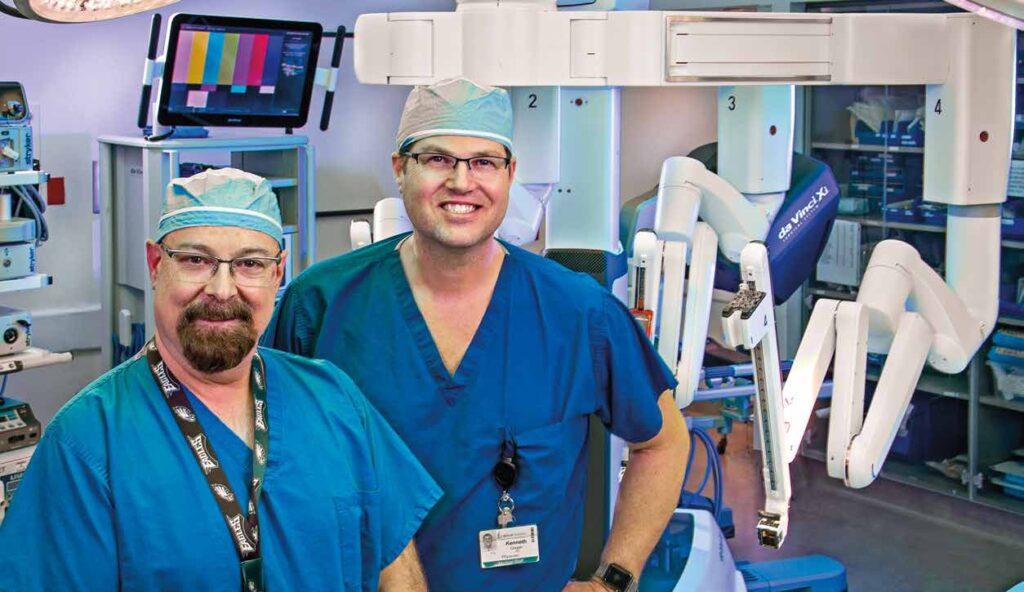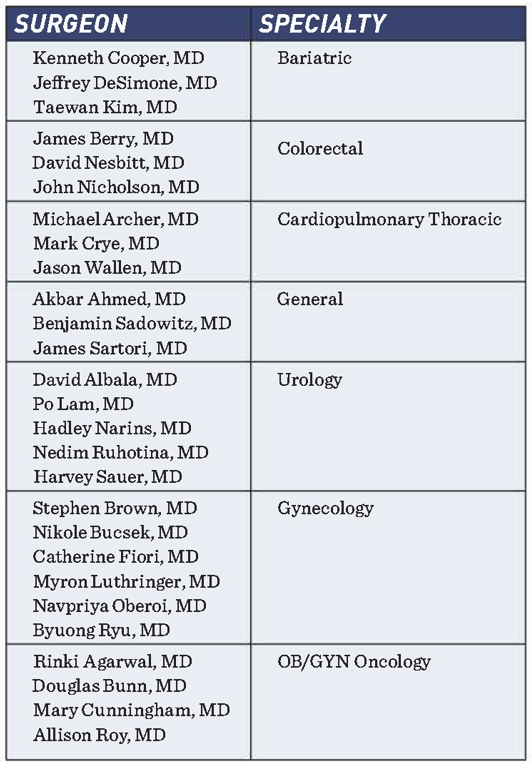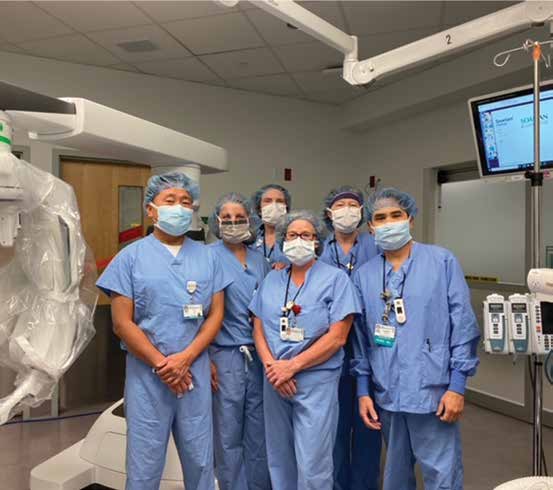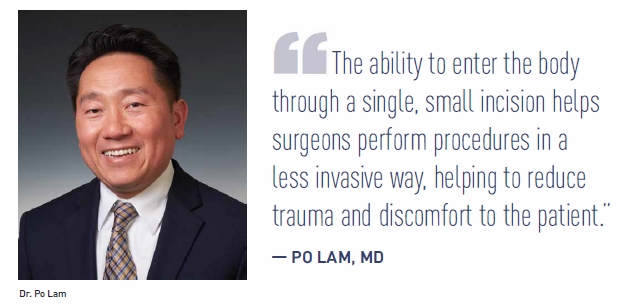BY BECCA TAURISANO

Kenneth Cooper, DO, (right] and Jeffrey DeSimone, MD, with the da Vinci Robot
CROUSE HOSPITAL’S ROBOTICASSISTED SURGERY PROGRAM IS THE LARGEST AND MOST SUCCESSFUL IN CENTRAL NEW YORK, THANKS TO THE COLLECTIVE EXPERTISE AND SUPPORT OF THE SURGEONS PARTICIPATING IN THE PROGRAM.
SINCE IT STARTE D in 2008, the robotic-assisted surgery program at Crouse Hospital has grown to include seven robotic platforms, with six da Vinci XI systems and the latest addition ofa da Vinci Single Port (SP) system, the only one in Central New York. The program’s surgeons have completed over 14,000 procedures in the areas of general, bariatric, colorectal, thoracic surgery, GYN oncology, gynecology, and urology. Grouse’s commitment to the success of the program ensures the region’s largest multispecialty robotics surgery program will continue to flourish, enhancing the patient experience and benefiting the community as a whole.
Kenneth Cooper, DO, and Jeffrey DeSimone, MD, use the robotic platform to perform gastric bypass and sleeve gastrectomy bariatric surgery. When the da Vinci XI, a
four-arm robotics system, was released in 2014, Dr. Cooper says it was a game changer compared to laparoscopic surgeries.
“The robotic-assisted technology provided patients with a less invasive surgical experience, and made it more comfortable
for surgeons,” Dr. Cooper says, citing the physical challenges surgeons have when working on patients with an elevated body mass index (BMI). The da Vinci XI allows Drs. Cooper and DeSimone to perform bariatric procedures in ways they could not do laparoscopically.
“We didn’t think we could improve upon laparoscopic surgery, but the data we have collected has shown that robotic surgery is an excellent option for our patients,” Dr. Cooper says.
Incision sizes with the robot are similar to laparoscopic incisions, but patients recover faster and have shorter hospital stays. In addition, robotic-assisted surgery significantly reduces the need for postoperative narcotics among bariatric surgery patients, who are able to return to work faster with fewer incision issues requiring wound care.


Po Lam, MD, (left] and team
“We were a Center of Excellence three times over before robotics, so we didn’t think we could improve on our excellent outcomes, but we did,” Dr. Cooper says
Surgeons have greater control with the Da Vinci XI technology, allowing them to toggle between the four arms, which include surgical instruments and a camera. “You can see detail you couldn’t see otherwise,” Dr. Cooper says. “That allows us to visualize much more clearly, especially in patients with a large amount of intra-abdominal tissue.”
The robotic instruments can be rotated like a human wrist in multiple planes, allowing surgeons to operate in tight spaces and use both hands with complete dexterity. The
instruments themselves are high-tech and smaller in size, which reduces the potential for complications and bleeding. The technology allows surgeons to perform procedures faster and with more efficiency.
“Anything that is an advantage for me as a surgeon is going to translate into an improvement for our patients,” says Dr. DeSimone.
Introducing robotics technology into the operating room has changed the skill set needed for the surgical team. Every member of the team must be able to prepare for next steps before the surgeon performs them, streamlining the entire process. Dr. DeSimone refers to this process as a highly choreographed dance. Highly-skilled personnel that possess the knowledge of the robotic platform and equipment are essential to ensuring a case is completed quickly and efficiently.
“We heavily rely on other individuals to do their part so we can provide the safest care for our patients. It is truly a team approach and we are very efficient with the use of our time,”
says Dr. DeSimone.
Urology surgeon Po Lam, MD, performs prostatectomies using the da Vinci SP (Single Port) robot, which has a single
arm, or port. Originally, the SP unit was mostly utilized by teaching hospitals to refine surgical techniques done with multiport systems.

“The SP platform puts Crouse in a very unique position, as it is the only system of its kind in Central New York,” Dr. Lam says.
In addition to the change from multiple ports to one port, the instrumentation with the SP system is more flexible. Dr. Lam explains that the flexibility of the instrumentation and the
camera allows the surgeon to work in tight spaces they could not access before.
“It allows for an innovative way to do the same surgery in a more confined space,” says Dr. Lam. “With the availability of the SP, there’s no reason to perform prostate surgery any other way.”
For Dr. Lam’s patients, there are numerous benefits to having robotic-assisted surgery with the da Vinci SP.
“We can reduce the risk of damage to the intestines or large blood vessels and avoid scar tissue that may exist due to a patient’s prior abdominal surgeries.”
The positioning of the patient is different with the SP robot as well. During a laparoscopic prostatectomy, a patient is placed with their head down and feet up, creating potential issues to maintain proper breathing during anesthesia. By eliminating this positioning during robotic surgery, patients have fewer issues and faster recovery.
“The real impetus to do this is that it’s ultimately better for our patients,” says Dr. Lam From the beginning of the robotics program in 2008, Crouse has been the regional leader in the field of robotics surgery, ensuring that their surgeons have the resources they need to be on the cutting edge.
“To their credit, Crouse leadership understood the advantages of robotic surgery early on and has done a great job of nurturing the program,” Dr. De Simone says. Bariatric patients require special equipment and furnishings to accommodate their size and Crouse provided them with everything they need on their own floor, making an overnight stay in the hospital more comfortable. “We have never been faced with a lack of institutional support,” Dr. Cooper says






